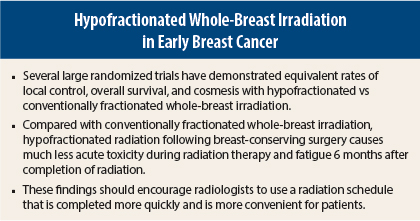Hypofractionated whole-breast irradiation was associated with much less acute toxicity during radiation therapy compared with conventionally fractionated whole-breast irradiation and also led to improved physical well-being and less physician-reported and patient-reported fatigue 6 months later, according to results of a randomized controlled trial. This is one of the first trials to compare these treatments in patients given contemporary radiation therapy with a tumor bed boost.
“Hypofractionated whole-breast irradiation results in less toxicity than conventionally fractionated whole-breast irradiation, even when a tumor bed boost is delivered,” stated lead author Simona F. Shaitelman, MD, EdM, of The University of Texas MD Anderson Cancer Center, Houston, Texas, who presented the results at the 56th Annual Meeting of the American Society for Radiation Oncology (ASTRO).
At least four large randomized trials have compared hypofractionated vs conventionally fractionated whole-breast irradiation, she said, showing equivalent rates of local control, overall survival, and cosmesis.
“But none of these trials mandated a tumor bed boost, which is widely used in the United States and Europe and reflects contemporary treatment,” she said.
Study Details
Patients with early-stage breast cancer (stage 0–II) treated with breast-conserving surgery with negative margins who were eligible for whole-breast irradiation were randomly assigned to either hypofractionated (n = 138) or conventionally fractionated whole-breast irradiation (n = 149). Hypofractionation was delivered at 42.56 Gy in 16 fractions over 20 to 21 days, followed by a tumor bed boost of 10 to 12.5 Gy in 4 to 5 fractions; conventional fractionation was delivered at 50 Gy in 25 fractions over 30 to 32 days, followed by a tumor bed boost of 10 to 14 Gy in 5 to 7 fractions.
The primary objective of the present trial was cosmesis at 3 years; secondary endpoints included maximal acute toxicities and quality of life assessed by the FACT-B questionnaire, which includes fatigue, nausea, caring for family, pain, and feelings of distress.
Of 432 patients screened, 287 were randomly assigned. Patients were excluded if they had a history of breast cancer, concurrent bilateral breast cancer, or were pregnant. They were assessed for acute toxicity during radiation treatment and then followed for 6 months.
Prior to starting treatment, 91% in the conventional fractionation arm and 95% in the hypofractionated arm had good to excellent cosmesis. Most of the women were between the ages of 50 and 70, 88% were postmenopausal, and 75% were overweight or obese. Three-quarters had invasive breast cancer; 25% were grade 3; the majority were estrogen receptor–positive and progesterone receptive–positive; and 8% were HER2-positive.
Greater Toxicity With Conventional Fractionation
Acute toxicity was significantly worse on conventionally fractionated whole-breast irradiation vs hypofractionated whole-breast irradiation, as assessed by physicians. Grade 2 or higher acute toxicity was reported in 46.4% of the hypofractionated patients vs 77.9% of the conventionally fractionationated group (P < .001); grade 3 or higher acute toxicity occurred in 0% vs 5.4%, respectively (P = .006). Acute fatigue was reported in 8.7% vs 16.7%, respectively (P = .02). Results also strongly favored hypofractionation over conventional fractionation for acute pruritus, breast pain, dermatitis, and hyperpigmentation.
At 6 months after completion of radiation, patients randomly assigned to hypofractionated whole-breast irradiation showed a strong trend toward better physical well-being on FACT-B scoring than those treated with conventionally fractionated whole-breast irradiation (P = .07), as well as less patient- and physician-reported fatigue (P < .001 and P = .009, respectively). ■
Disclosure: Dr. Shaitelman received a research grant from Elekta, and Dr. Smith (the senior author in the study) has a research grant from Varian.
Reference
1. Shaitelman S, Buchholz TA, Hunt KK, et al: Hypofractionated whole breast irradiation results in less acute toxicity and improved quality of life at 6 months compared to conventionally fractionated whole breast irradiation: Results of a randomized trial. ASTRO Annual Meeting. Abstract LBA3. Presented September 14, 2014.



